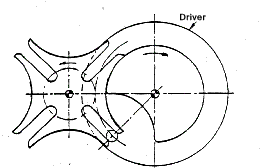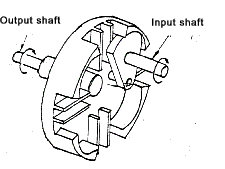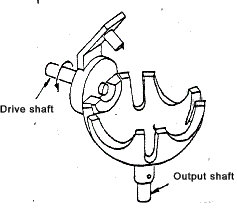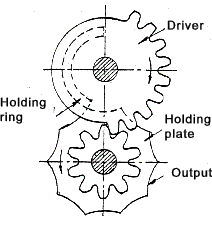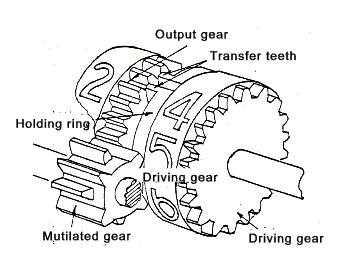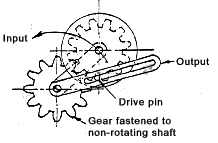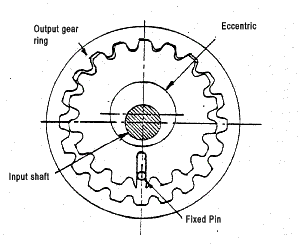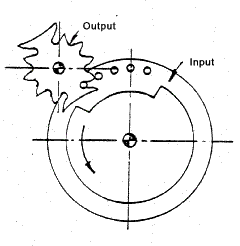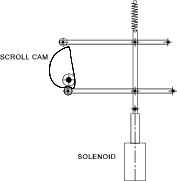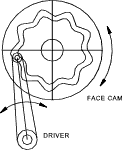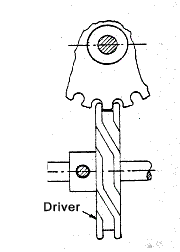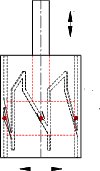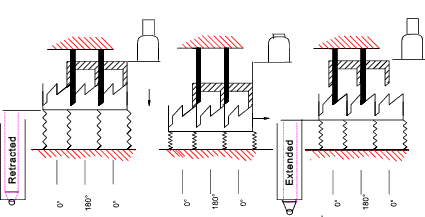| |
Mechanism general notes
Indexing Mechanisms
More details on Indexing Mechanism design are to be found in the links below the table
|
Indexing Mechanisms Geneva Mechanisms There are three basic types of Geneva motion as shown in the figures below.
Because the driven wheel in a Geneva motion is always under full control of the driver
there is no problem with overrunning. Impact is till a problem unless the slots of the
driven wheel are accurately made and the driving pin enters these slots at the proper angle.
For best results the pin should be shaped so tht the pin picks up the driven member as slowly as
possible. Impact can also be reduced by leaving the top and bottom of the slot open.
The fingers that form the slot will then have some resiliency. However strength
is of primary importance and the slot must be bridged by a web . Gears can be used in several ways to produce intermittent motion. A typical unit
is the "mutilated gear" shown in the figure below. In this case some of
the teeth have been removed from the driver and a partial holding surface has been added to
each gear to prevent slight rotation of the drum gear during the dwell period.
A desirable feature with mutilated gears is their indexing accuracy and in addition to the inherent accuracy of the gears, the output is always under control on the input. Mutilated gears as shown below are used in almost all counters, they are inexpensive reasonably precise and efficient. They stand up well under the type of loading found in instruments. The mutilated pinions as shown below are virtually identical to the gear above except that the locking ring on the output gear has been eliminated. Every other tooth on the input end of the pinion has been cut away so that the remaining teeth can hold the pinion during dwell periods . In counters the driver has only two teeth, but it can have any even number of teeth.
With cycloidal intermittent gearing the input and output remains in constant mesh. Cycloidal gearing provides considerable latitude in selection of operating characteristics- decelerations, dwell periods, ratio of input to output motions etc. A basic cycloidal mechanism is shown in the figure below. In this type the drive pin or roller must on the pitch circle of the planet gear if the output crank is to stop, Otherwise, the output will either slow and not stop or actually reverse the motion.
There are many other variations of this type of mechanism including hyper-cycloidal , epicycloidal &
peri-cycloidal arrangements. These devices are very versatile and can be used with
Genevas for additional output variations.
A different type of intermittent motion mechanism is the star wheel. In the arrangement shown in the figure below pins are used as teeth on the driver, but involute teeth can be used instead. This is another versatile mechanism. It provides considerable freedom in choosing operating parameters. The output wheel for example can be made to rotate more than one revolution. This is not possible with pure simple genevas. Star wheel devices can rotate at different amounts at each index point. Accelerations and decelerations can be controlled more readily than in a mutilated gear pair." By careful shaping of the teeth. Internal pairs are also possible.
Various type of cams can be used to produce intermittent indexing rotations. As an example the scroll-shaped disc cam shown below indexes a wheel 180o when the solenoid pulls the levers down and a further 180o when the solenoid is releases the levers.
A face cam as shown below is also often used for indexing. The reciprocating drive arm moves a pin or roller back and forth in the zig -zag groove in the face of the wheel. This simple arrangement is used in moderate speed counters. As with many inexpensive cam drives efficiency is not high. Impact is light particularly if the drive arm is itself driven by a properly shaped cam. In this form of drive there is little danger of over travel.
A cylindrical cam as shown below can serve as the driver in another type of indexing drive. a typical commercial unit can handle moderate to high loads at speeds of 1000 steps /minute.
The cam system shown below is used often for Sequenced grabs. Every time the centre shaft is lowered down the ring in which internal slots are machined is caused to rotate a fixed angle. This is used for sequenced grabs in which each alternate ring position conforms to a grab open position and the other positions conform to a grab locked closed position.
The mechanism shown below is a diagrammatic representation of a ball point retracting mechanism. In practice this mechanism is a cylindrical mechanism arranged such that at each press of the end projection the pen is sequentially extended and retracted. The diagram below show the cylinder flattened out to illustrate the action.
One significant advantage of cam drives over most other intermittent motion drives is that the cams can be shaped to control such dynamic factors as impact, acceleration and dwell periods. However since small changes in cam contour can result in significant changes in performance each design must be tailored to the particular application. |
Links to Mechanism Design
|
|
Machine_Parts_Index
Mechanism general notes
